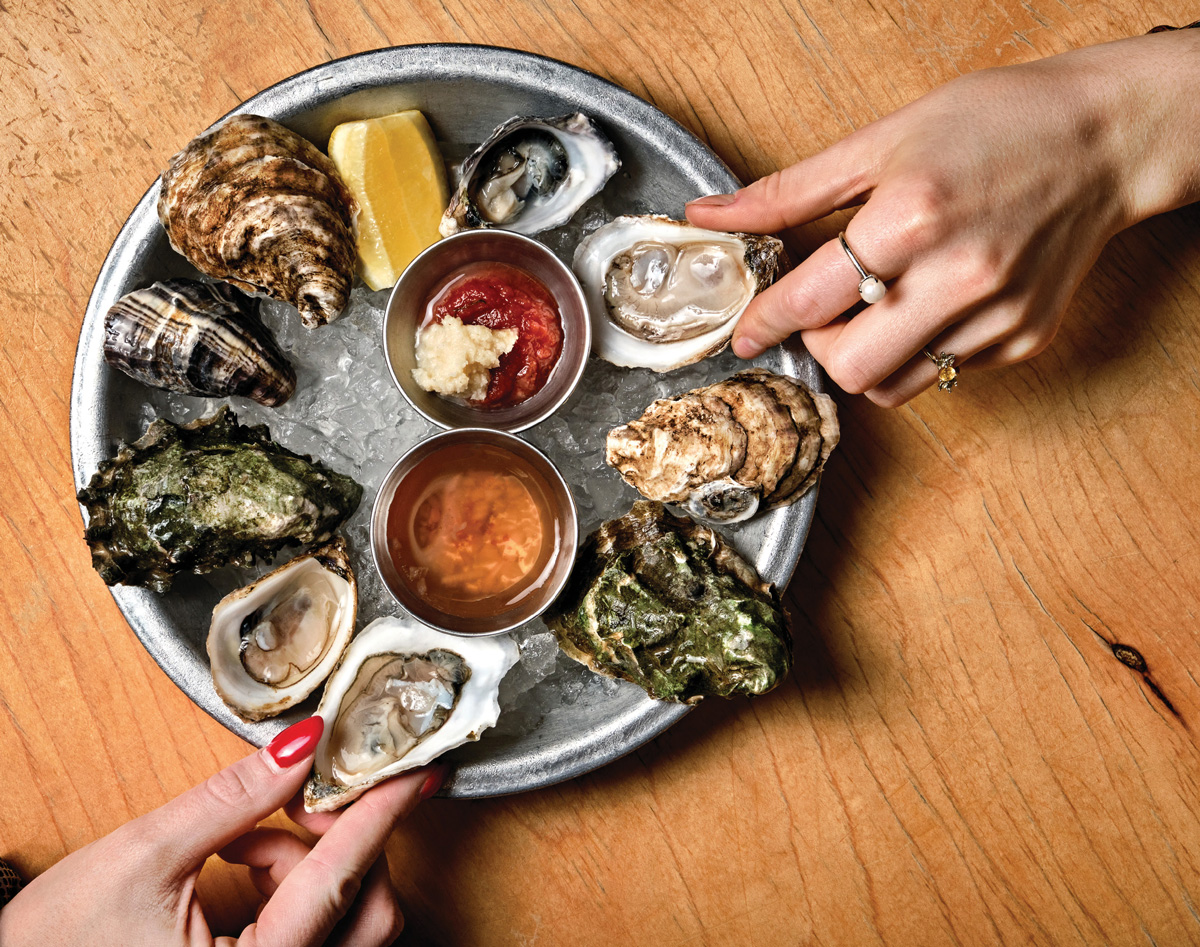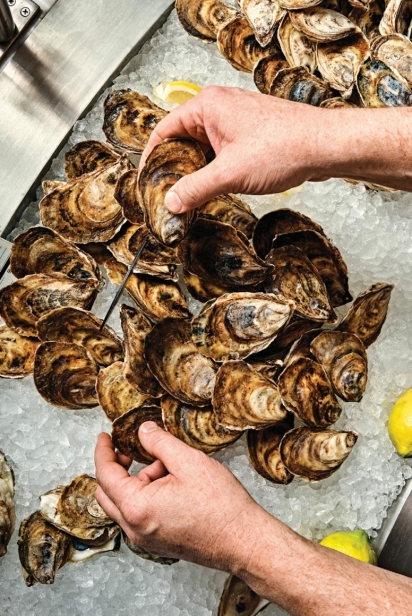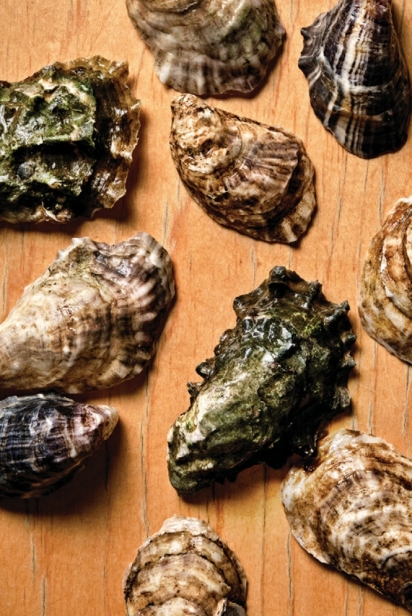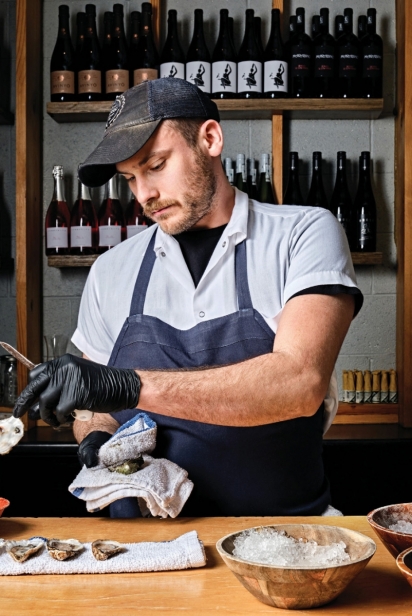The World Is Their Oyster
Restaurants like Brine Oyster House and Voyager are dedicated to bringing the oyster experience to Southeast Michigan, educating and delighting diners with the best and freshest shellfish they can find.
MICHIGAN, WHICH IS surrounded by four out of five Great Lakes, may not be the first place that comes to mind when one thinks of oysters. But chefs passionate about this delicacy are showcasing the experience of feasting on fresh oysters from the coasts.
At Brine Oyster House in Grosse Pointe and Voyager in Ferndale, oysters are the main draw. These establishments collectively serve an impressive 1,000 oysters per week, with the potential to triple during peak seasons. The oyster experience is the heartbeat of these restaurants, attracting enthusiasts with their exceptional offerings.
Chef Ray Garrett of Voyager and Chef Gavin Russell of Brine share a preference for Canadian oysters, particularly favoring East Cape, also recognized as Prince Edward Island (PEI), and Fortune from Nova Scotia. These choices aren’t just personal favorites; they’ve also proven to be crowd-pleasers, making them an excellent choice for those embarking on their first journey into the world of bivalve mollusks.
Their inclination toward Canadian oysters goes beyond the distinctive flavors; it’s also rooted in practicality, given that these Canadian varieties are notably easier to open. The Prince Edward Island and New Brunswick oysters are distinguished by a clean, crisp brine and a distinctly savory finish. The sourcing strategy is deliberate, with factors such as availability and pricing playing a crucial role in the selection process.
They don’t exclusively source from Canada; both the East and West coasts provide plenty of options and each presents its unique appeal.
Among the local favorites, a standout selection includes Kumamoto Oysters from Washington. These oysters, often endearingly called “Kumies,” are prized for their fruity, sweet, melon-scented flavor and light brininess. Originating in Japan, they find their home predominantly in the Pacific Northwest. Moonrock Oysters, hailing from Oregon, present a delightful combination of sweetness and fruity notes housed in distinct deep, bowl-shaped shells. Lastly, Mystic Oysters from Connecticut offer a nuanced experience with their gentle brine, springy meats and a flinty finish. Each of these regional favorites adds a unique touch to the oyster scene, showcasing the diverse and exquisite flavors found in local waters.
Oysters, known to thrive in saltwater and brackish water, inhabit regions with a salinity level somewhere between freshwater and seawater. Factors such as proximity to the coast, freshwater inputs from rivers and streams, and evaporation influence the variability in the salinity of brackish water.
Garrett says the taste of an oyster is intricately linked to the specific body of water where it grew, adding a layer of individuality to each mollusk’s flavor profile. He adds that the salinity of the water they inhabit directly influences the key components of an oyster’s diet—plankton and algae—consequently impacting their taste. Oysters that reside in saltier waters tend to exhibit a saltier flavor profile, whereas those in milder water present a more delicate taste.
“East Coast oysters tend to get a lot of love around here,” explains Garrett. “The West Coast ones do have a dedicated following, but it’s much smaller for several reasons.”
Oysters are “very sustainable,” Russell says.
“I think it’s probably the same for any farm item, as long as it’s not monoculture to the extreme in any area; they filter and clean out the water. So, in terms of farming, they’re very sustainable, and we have a great relationship with suppliers like Motor City Seafood and Carmela, who are meticulous about their sourcing and keeping up to date with the endangered seafood lists.”
Both chefs emphasize the importance of maintaining strong ties with their suppliers, a relationship deemed vital due to the geographical distance from the sources.
Prior to the launch of Brine Oyster House, the chefs frequently undertook journeys to meet with the farmers responsible for cultivating the mollusks. This hands-on approach aimed to gain a deeper understanding of the farming processes.
Says Russell, “Once you know how they’re sourced, it becomes an easy sell to our guests. Being a freshwater state instead of a saltwater one, we hold great concern for these matters.”
Russell routinely engages with guests new to oysters, seeking to understand whether the flavor or the gelatinous, mucus-like texture may give them pause.
“For most people, it’s texture,” he points out. “So I’ll offer to fry them a couple of oysters, and if they enjoy those, then we know they appreciate the flavor. Afterward, we encourage them to try one or two raw, and we consistently present the Canadian ones. They boast a delightful salinity and are an easy-to-enjoy oyster. Many become enamored with that particular oyster and expand their palate by trying more once they discover its appeal.”
To relish oysters, Russell and Garrett recommend enjoying them “simply dressed,” incorporating only a touch of lemon juice or a light mignonette—a condiment crafted from vinegar, minced shallots and pepper. Voyager enhances their version with a hint of champagne, while Brine opts for a subtle touch of honey. In the Midwest, the paramount attribute of oyster flavor is its cleanliness, satisfying guests who often seek a taste reminiscent of the ocean.
The chefs recommend bubbles and high-acid white wines like Sauvignon Blanc, Assyrtiko from Greece or Albariño from Spain and Portugal to match up to oysters’ briny flavor. However, they caution against overpowering the simple flavor of the oysters with horseradish and cocktail sauce, with Brine specifically omitting cocktail sauce from its offerings.
A less traditional pairing is beer.
“I also love a very unconventional pairing of a stout, particularly Guinness, with oysters,” says Russell. “We make a stout mignonette, which adds an interesting dimension to the experience.”
In a culinary twist, the pairing of stout and oysters creates a unique flavor by envisioning substituting traditional Baileys with oysters. Brine Oyster House further elevates this unlikely pairing with a robust dish featuring braised beef shank immersed in Guinness broth, adding oysters. The tradition of pairing oysters with stout dates to the 18th and 19th centuries in Ireland and the UK. In this historical practice, oysters’ natural brininess and subtle sweetness complement the rich and roasted flavors of the stout.
“When it comes to oysters, I believe the experience speaks for itself,” concludes Garrett. “Enjoy it, feel confident about it and, most of all, savor the delight of eating oysters.”
Brine Oyster House
Grosse Pointe Park
Voyager
Ferndale
Courtney Burk is a writer whose work primarily focuses on the hospitality industry across Metro Detroit. Being a restaurant kid, she found her love of storytelling through food and the narratives of those within the industry. When she’s not writing, she can be found in the garden, working on new projects with her husband and enjoying the Great Lakes with her rescue mutts. Visit yeahnoforsure.co to check out her work.










